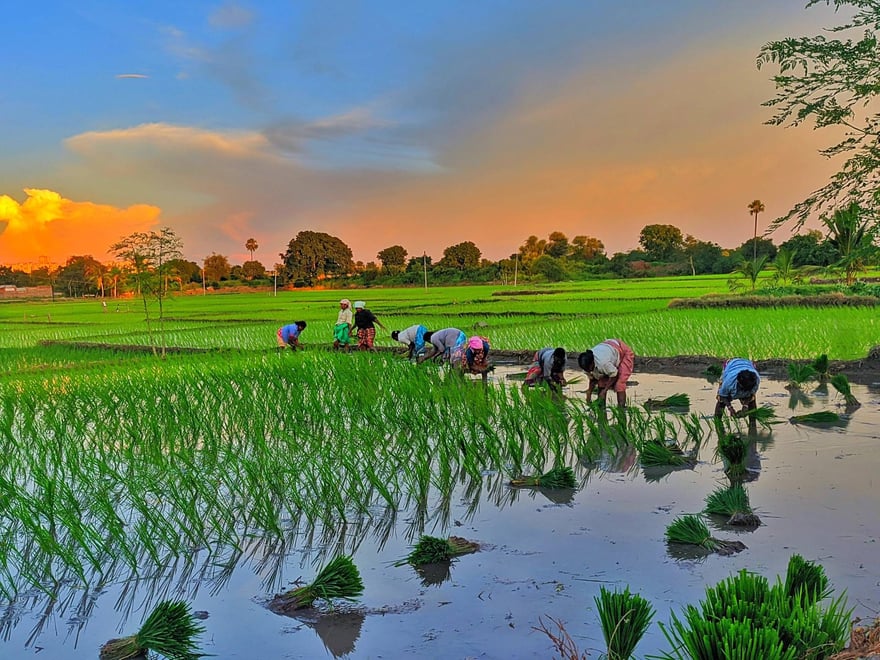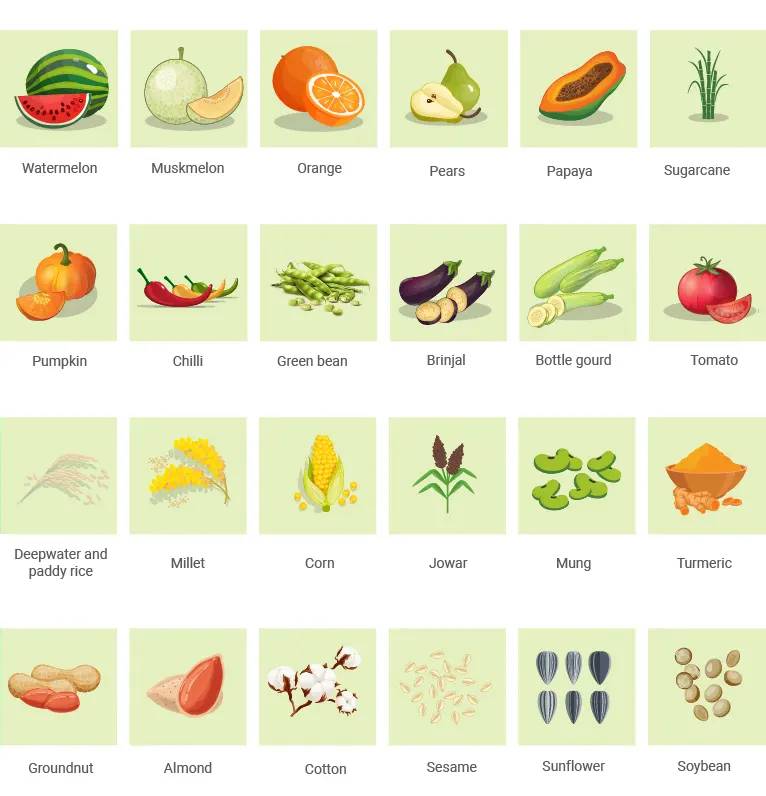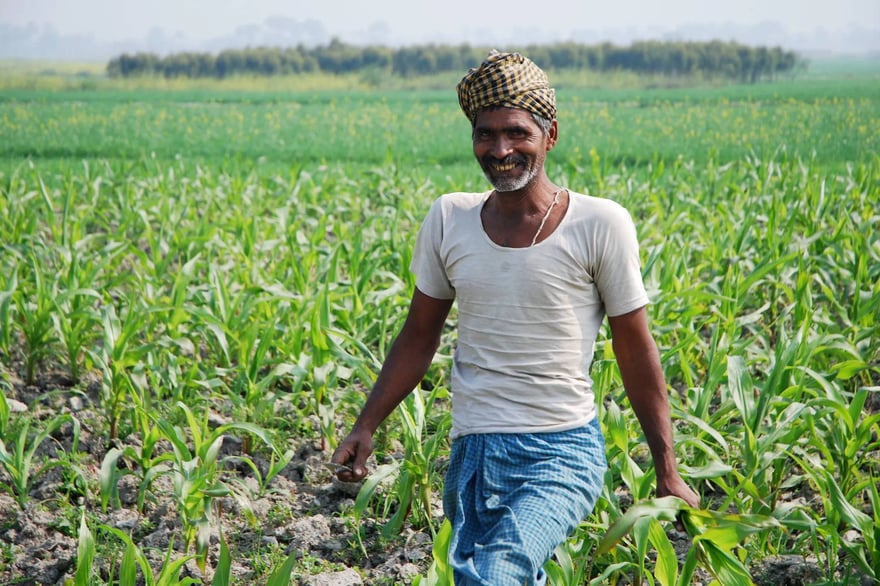Kharif crops are agricultural crops that are planted in the monsoon season, typically in June or July, and harvested in September or October. These crops are well-suited to regions with heavy rainfall and warm climates and include rice, maize, soybean, cotton, and various pulses. They are an essential part of agriculture in many parts of the world, especially in tropical and subtropical regions where the monsoon season provides ample water for crops to grow. These crops have been a staple food source for countless communities for centuries and have played a significant role in shaping the economies and cultures of these regions.
For example, in India, Kharif crops such as rice, maize, and cotton are grown on millions of acres of land and provide livelihoods for millions of farmers. In addition to being a staple food source, these crops also play a vital role in the country's economy and are exported to other countries, helping to boost the country's economy.
In Africa, countries like Nigeria and Ethiopia are among the largest producers of Kharif crops like maize, soybean, and groundnuts, which are important sources of food, feed, and oil. The cultivation of these crops is also a critical factor in the socio-economic development of these countries, providing jobs, income, and food security for rural communities.
The Kharif season also brings with it a unique cultural significance in many parts of the world, with traditional festivals and celebrations being held in honor of the bountiful harvest. These crops are a symbol of hope, prosperity, and a better future for countless communities, and their cultivation has helped to shape the landscape and the way of life for generations.
Kharif crops make up most of the agricultural produce in the coastal states of West Bengal, Andhra Pradesh, Odisha, Telangana, Maharashtra, Kerala, Tamil Nadu, and Assam in India, and in the neighboring countries of Pakistan and Bangladesh. These are rain-fed crops heavily dependent on the southwest monsoon winds, accounting for 75% of India’s total rainfall.
Such reliance on rain also makes the cultivation of these seasonal crops increasingly challenging and unpredictable. As of March 2021, the planting of Kharif crops has only seen 56.50 lakh ha coverage throughout India. In such a scenario, precision agriculture, employing the latest technological advancements, comes as a solution to these standing issues.

Photo by Prahlad Inala on Unsplash
A Closer Look at the Kharif Season
The word Kharif originally finds its place in the Arabic language, wherein it means “autumn”. This is because farmers generally harvest Kharif crops at the beginning of autumn. The sowing of seeds takes place around the first spell of the monsoon. Kharif crops are also called summer crops or monsoon crops since their duration of cultivation coincides with these seasons.
Primarily associated with the monsoon, the exact duration of the Kharif season may vary across regions and crops. In India, this season roughly starts around June and ends in October. However, this period can vary for different states in the country. For instance, farmers in Kerala sow Kharif crops near the end of May. On the other hand, those in North Indian states plant crops in July, depending on the arrival of the monsoon.
Here is a list of some major Kharif crops.

Cultivating seasonal crops has its own challenges. However, the primary concern for Kharif crops is their reliance on the timely arrival of rainfall and adequate precipitation during the period of cultivation. This is precisely where precision agriculture can help farmers streamline the entire process.
Seasonal Kharif Crop Production Challenges

Here is a list of some common hurdles that interfere with Kharif crop cultivation.
1. The Unpredictability of Monsoons during Sowing Stages
Unlike areas in Australia and West Africa, monsoons in India are highly unpredictable. At the same time, the monsoon accounts for 80% of the country’s total rainfall, and the sowing of Kharif crops is heavily dependent on the first rain. The unpredictability could result in delayed arrival of monsoon, scanty rain, or even flood.
Odisha is a notable victim of the same in the current Kharif season. According to the India Meteorological Department (IMD) of Bhubaneswar, the state received 181.3 mm of rainfall on average in June 2021. Compared to its usual 210.7 mm rainfall, this is a staggering 17% deficit. Owing to this, farmers had to postpone paddy transplantation to July instead of June’s third week.
2. Lack of Adequate and Timely Access to Seeds and Agrochemicals
One of the many things the COVID-19 pandemic has disrupted is intra- and inter-state transportation of agricultural supplies due to nationwide lockdowns. During last year’s Kharif season, estimates suggested that around 20% of Indian farmers may not get access to fertilizers, seeds, and other agricultural inputs. This year, farmers in Madhya Pradesh reported a shortage of quality soybean seeds. Odisha, on the other hand, faced a fertilizer crisis well into the sowing season. It leads to a manifold problem for these farmers who are already reeling from the destructive impact of cyclone Yaas.
3. Poor Access to Credit
Adequate financing is crucial to help an agrarian economy thrive. Although the government curated several financing schemes for this cause, most of their benefits are yet to reach the small farmers.
A majority of smallholder farmers depend on private lending. However, those relying on traditional farming methods amidst a poor agricultural season are bound to face underproduction and eventual debt. As a result, financial institutions become reluctant to lend to such individuals any further, resulting in an ongoing debt cycle.
4. Insufficient Advisories, Services, and Information on Agri Practices
The lack of knowledge about agricultural inputs, the latest prices, and scientific farm management practices exposes farmers to uncertainty and risks. Be it uncertain weather conditions, the need to effectively manage pest infestations, or understanding the correct usage of fertilizers, growers need timely guidance to ensure minimal crop loss and higher crop productivity. This is where smart farming comes into the picture as a savior. Access to up-to-date information can help curb the impact of such challenges on crop production.
5. Limited Capacity to Monitor In-season Crop Risks
During the period of cultivation, there are several factors that can impact the yield, many of which the growers will be able to monitor and take preventive or corrective measures for, such as unfavorable weather conditions, the arrival of pests or crop disease, and poor soil nutrition. Failing to handle these crop stresses in a timely manner can negatively impact the overall yield and quality of the crop, thus resulting in poor returns for the farmer.
6. Inadequate Data to Estimate Harvest Date and Yield
Large farming companies may find it difficult to keep tabs on the production cycles of individual farms. If the cycle did not go as planned, such as in the case of delays in sowing due to rains, it would be more difficult to estimate the harvest date and output. This can cause complications in planning for post-harvest processes. Not being able to estimate the yield quantity or the harvest date is also one of the biggest challenges in sourcing or procuring agri-commodity. It renders them difficult to plan downstream processes.
Digital Interventions to Overcome the Glaring Challenges

Agriculture technology can help farmers overcome the challenges mentioned above effectively. Here are some of the ways.
1. Sowing Date Estimation For Higher Crop Productivity
Cropin uses satellite monitoring, machine learning, and weather data to recommend a sowing window that will reduce uncertainty and maximize the quality and quality of yield. With such predictive analysis, farmers can know their ideal sowing date as per climate predictions and drive climate-smart agriculture in the face of changing weather patterns.
2. Crop Advisories and PoP Management Through a Digital Platform
With SmartFarm, farming, and seed companies can guide farmers to achieve optimal productivity with expert-recommended crop advisories. They can also configure PoP (package of practices) for 380+ crops and 9500+ crop varieties for all stages of crop production. The companies can eliminate all paperwork and digitally monitor the implementation of PoP at plot and farmer levels. Consequently, this will aid in improved crop protection and agri-productivity.
3. Continuous Satellite Monitoring for Health and Crop Stage Assessment
SmartRisk facilitates precision agriculture with the use of AI. Using satellite monitoring and proprietary deep-learning algorithms, SmartRisk can notify agribusinesses about any change in crop health caused due to various factors, thereby enabling them to spot anomalies in a timely manner. The AI platform empowers agribusinesses with comprehensive insights on crop health, early warning for diseases, crop stage detection, yield assessment, and more. Further, agribusinesses can make decisions based on the crop stage, such as ensuring the availability of farm equipment and machinery and scheduling irrigation.
4. Ensuring Farmer Access to Quality Credit in a Timely and Systematic Manner
Besides aiding crop production, precision agriculture also provides alternate agri-data, both historical and predictive, for financial institutions to make data-driven decisions regarding their investments. In circumstances where smallholder farmers cannot present enough proof of their agricultural activities, this alternate data facilitates the institutions to appraise loan applications with ease, bringing down the time, effort, and costs it typically takes to process the loan without enough information. With SmartRisk, financial institutions can also monitor fund utilization and identify the right time to recover payments based on the estimated harvest period.
5. Predictive Insights for Marketing and Sales Strategies
Besides weather advisory and yield predictions, SmartRisk also helps agri-input companies develop a focused sales and marketing strategy. The platform facilitates such benefits by analyzing areas under cultivation, the crop stage, and current health, with data insights on historical crop production. Agrochemical companies and manufacturers and distributors of farm machinery can analyze these insights at a regional level to ensure farmers have easy access to their products at the right time. Additionally, these companies can use AcreSquare to connect with farmers directly to upsell and cross-sell these products, thereby increasing their sales and customer loyalty.
6. Intelligent Estimation of Harvest Date and Potential Yield to Optimise Post-harvest Decisions
Cropin also aids in predicting the harvest date using remote sensing technology and AI. This is based on near-real-time 360-degree farm monitoring with SmartFarm and predictive agri-productivity analysis via SmartRisk. Farming companies can plan post-harvest decisions like aggregation, distribution, and exports accordingly, while sourcing and procurement companies can gain insight into the estimated production quantity and harvest window several weeks in advance. Government entities can use this intelligence to assess the area under cultivation for a specific crop and the potential yield to make procurement decisions. It can further enable them to update agricultural policies in favor of the growers.
Rapid advancements in the industrial and services sectors have helped these areas see remarkable economic progress in the preceding years. While agriculture was slow to adopt digital innovations, the current use of smart farming technologies to digitize and industrialize this sector and the opportunities for the widespread application of precision agriculture to boost crop productivity can immensely benefit farmers and associated brands.






